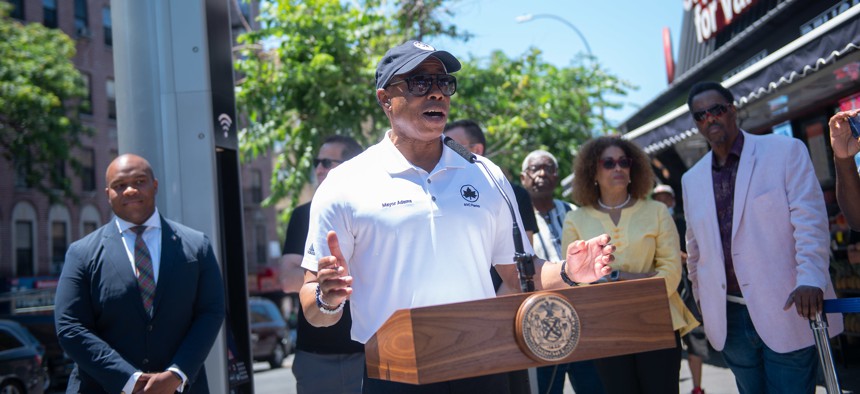The towering 5G-transmitting poles that have started to sprout up across the city like supertall sci-fi weeds have been met with their fair share of criticism. An update to the LinkNYC kiosks first rolled out by tech consortium CityBridge in 2016, the new towers feature many of the same charging, Wi-Fi and advertising capabilities as the current kiosks, but measure in at 32 feet tall with 5G transmitting equipment.
Rep. Jerry Nadler notably raised concerns that the towers will look and feel out of place in the city’s historic districts. Some Community Boards have also opposed installation of the towers.
But ahead of a City Council hearing on the deployment of Link5G towers on Wednesday, a group of business leaders in the city is speaking up in defense of the digital infrastructure rollout. “LinkNYC has already become the largest free public Wi-Fi network in the world, providing high-speed internet access to more than 13 million people,” the letter, addressed to Mayor Eric Adams and City Council Speaker Adrienne Adams, and shared exclusively with City & State, read. “Link5G is the next phase of the LinkNYC program, providing critical infrastructure investment to marginalized communities of color.” The letter was signed by 25 business and community leaders including Partnership for New York City President Kathy Wylde and Tech:NYC President Julie Samuels; the leaders of the city’s chambers of commerce; and the business manager of the International Brotherhood of Electrical Workers Local 3.
The deployment of the original LinkNYC kiosks over the last decade hasn’t come without obstacles. CityBridge has caught flak from city officials for installing a fraction of the kiosks it agreed to, with most of the kiosks being built in Manhattan. The vast majority of Link5G kiosks are now required to be built in the outer boroughs and north of 96th Street in Manhattan.
The updated Link5G infrastructure has been pitched as an important step in addressing the digital divide in New York City. The letter from business leaders cast those opposing the towers as exhibiting a “not in my backyard” attitude – a phrase more commonly used of late to describe those who oppose new housing developments. The Link5G towers provide housing for telecommunications equipment, not humans. But proponents of the program said that the rollout of new kiosks will help New Yorkers in underserved areas by providing free Wi-Fi and calling, as well as 5G capability. “We are dismayed that opponents of Link5G are prioritizing their own interests over those of the entire city, and are particularly alarmed by certain privileged, wealthy communities pushing back against this essential service,” the letter reads. “Their requests all share the same message: ‘not in my backyard.’”
Mayor Adams, too, has pointed to the Link5G kiosks as a step in addressing the digital divide.
Following concerns that were raised about the towers’ placement in historic districts, the Federal Communications Commission sent a letter to CityBridge noting that it didn’t complete required reviews under the National Historic Preservation Act and the National Environmental Policy Act.
“First and foremost, I support broadband and Wi-Fi equity and access, and have supported efforts in Congress to (expand) access to high-speed internet for underserved communities. However, it's critical that any construction of Link5G towers by CityBridge are abiding by federal regulations,” Nadler said in an emailed statement, adding that it’s also “vital” that CityBridge work closely with community boards and neighborhood coalitions to address concerns about the infrastructure.
Wednesday’s hearing to be held by the Committee on Technology will cover the deployment of the Link5G infrastructure. Council Member Jennifer Gutiérrez, who chairs the technology committee, declined to comment on the Link5G program or the upcoming hearing.


